What springs to mind when you think Norway? Vikings? Snow? Fjords? Gorgeous people getting about in big furry hooded jackets on snowmobiles perhaps? Oslo wraps all of this up into a convenient, compact and historic Scandinavian experience in one city, easily accessible from the UK. Oslo is teeming with striking new architecture, intelligent design and a super efficient transport system – all wrapped up closely by hundreds of acres of snow capped, forest blanketed mountain ranges.
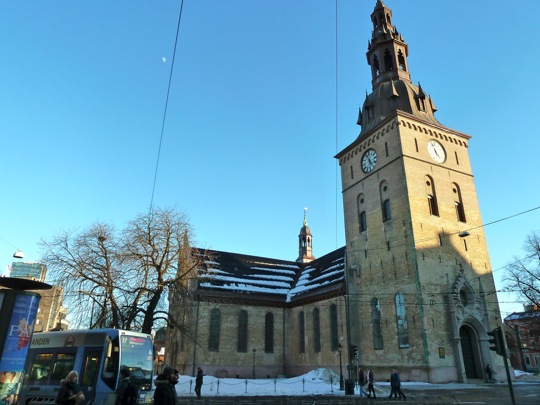 Oslo Cathedral – one of the last remaining medieval buildings.
Oslo Cathedral – one of the last remaining medieval buildings.
Norway was voted last year as the most expensive country in the world, which in turn makes Oslo the most expensive city in the world, but I’ll show you it’s possible to dodge and weave around this common misconception.
Things to See and Do
On the surface, Oslo doesn’t have a bunch of sights that jump out at you and steal your Euros and jam Middle Age bronze monuments down your throat. There’s a solid line up of museums to poke around in, the few remaining Medieval sights to hit up and along with some contemporary option. I’ve summarised a good bunch of worthwhile sights to check out below that will give you a good snapshot of the city and Norwegian culture as well.
Holmenkollen National Ski Arena
When I heard about this place I thought “huge ski jump?! Yes, let’s definitely go to Oslo”. This behemoth is an engineering masterpiece, and has evolved through various iterations in the last 120 years to become the huge, pinnacle of world ski jumping it is today. You can take a lift right to the top for a view of the entire site, deep into the pit where the ski jumpers and land as well as right across the city.
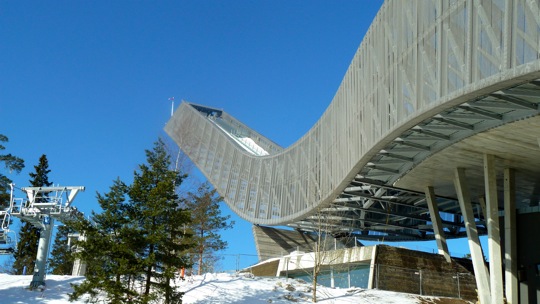
It also houses the Holmenkollen Ski Museum, which explains the sport in really easy to digest terms and how it’s evolved in Norway. It also explains how ingrained skiing is in Norwegian culture and how it became a conduit for the King to become closer to the people.
Viking Ship Museum
Yeah, now we’re talking. Get your pillaging skills honed kids, it’s time to get some Viking into you.
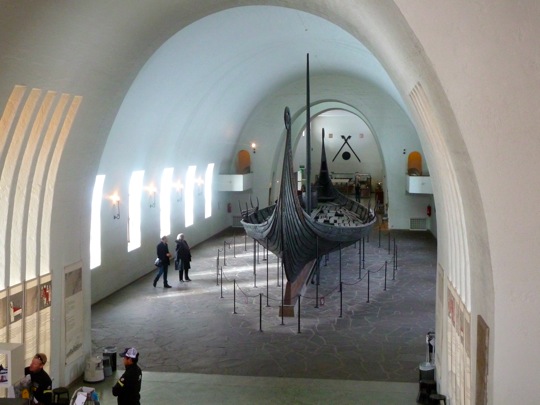
The VIking Ship Museum has 3 ships on display of varying styles, sizes and conditions. These ships are absolutely huge, and are adorned in extensive artistic detail. To walk next to boats associated with what we all commonly think of when we think Norway/Scandinavia from hundreds of years ago, and that were once responsible for carting loads of Vikings to capture towns in England, is a great experience.
Fram Museum
The Fram was the first ship built especially as an icebreaker in the late 19th century and saw service until 1912. It was used in the Norwegian expeditions to be the first to both the North and South Poles. Legendary adventurers like Fridtjof Nansen and Roald Amundsen captained the vessel to forge it’s name as one of the most important ships in expeditionary history.
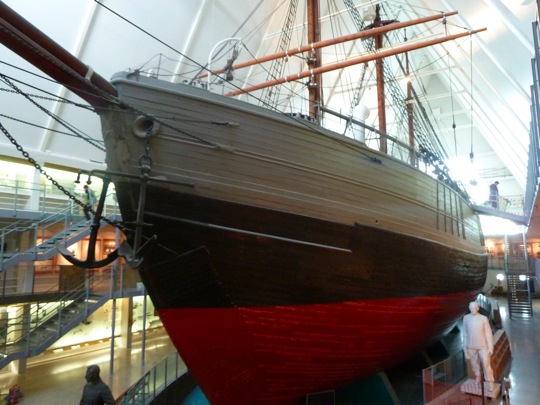
Definitely a really important museum to visit, as it tells a lot of the treacherous stories resulting from the extreme conditions experienced during the Polar expeditions, along with loads display cases with artifacts from the ship on show. Icing on the cake, you can actually walk onto the deck and in and around the bowels of the ship to get a feel of what it was like for hundreds of days at sea.
Akershus Fortress and the Norwegian Resistance Museum
This site has been important to Norwegian history for over 700 years, and represents one of the last remaining examples of classical European feudal military sites. The original castle was built around 1300, and was converted into a renaissance style castle in the 17th century and surrounded by a modern bastion. Today it is used as a headquarters for the Norwegian armed forces along with being a great public space to admire the surrounding harbour.
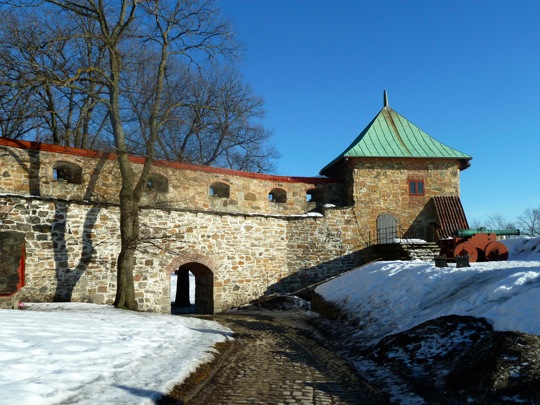
Also within the grounds is the Norwegian Resistance Museum, telling the harrowing story of the Nazi occupation of Norway. The exhibitions go into great detail about the hardships that were endured, how a resistance was formed from London by the exiled monarchy, and how after 5 years of occupation, Norway vowed never to have foreign rulers ever again and went onto form its own strong national identity.
Oslo City Hall
From the outside, it looks pretty plain. It looks like a big box with two bigger matchboxes stood on end on either side. What makes this building special however is that this is where, on the front steps each year, the Nobel Peace Prize is presented to the recipient. Construction was started in 1931 but was delayed by WW2, finally being opened in 1950 on Oslo Day, 15th May.
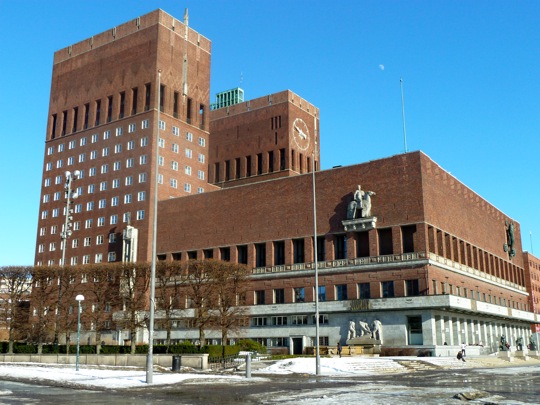
In addition to this, the central hall is CAV-ER-NOUS and each wall is draped with paintings depicting common Oslo life and how the mountains, the people and the fjord all live together. The drawing and assembly rooms that flank the main hall are also really impressive places to walk around in, allowing you to absorb the vast spaces of rich browns, greens and reds that make up the wallpapers and curtains. It’s open daily from 9am to 6pm and entrance is free.
Royal Palace
Located right near the transport hub of Nationaltheatret, the Royal Palace (Det Kongelige Slott in Norwegian) is the residence of the Norwegian royal family in Oslo. You can walk up the very regal main boulevard to approach the palace from the front and admire the well landscaped gardens that surround the large imposing building that look especially cool when covered in snow.
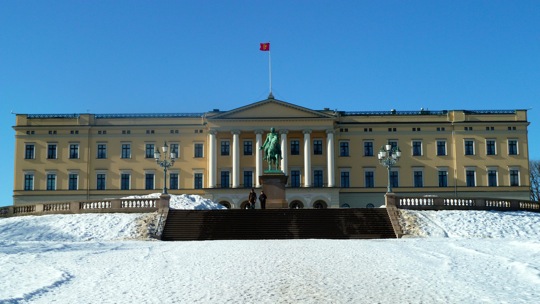
As Royal Palaces go, this isn’t the most lavishly adorned one around, or the busiest. Do a lap around to appreciate the architecture, then go grab yourself a coffee. Royal Guards patrol the grounds constantly, so you’ll most likely catch a glimpse of some Norwegian military pageantry in the form of a uniform/weapons inspection parade over to the side also.
Food/Drink
Oslo, like a lot of Europe, has a strong multicultural influence. This results in an eclectic mix of bars and restaurants, whilst at the same time maintaining a strong Norwegian presence. You can get yourself anything from a curry or a kebab, right through to a solid plate of Mexican or a hearty Scandinavian plate of boiled meat and veg. One point to mention, the entire time I was in Norway, I couldn’t for the life of me find still water. It seems the Norwegians have a real penchant for sparkling water only.
Norwegian Fast Food
Bacon Pølse
A hot dog wrapped in bacon? Where is the man that dreamt this fantastic treat up so I can shake his hand?! The Bacon Pølse is basically a sausage wrapped in bacon and you can get them EVERYWHERE. From service stations on the side of the highway to convenience stores in Oslo.
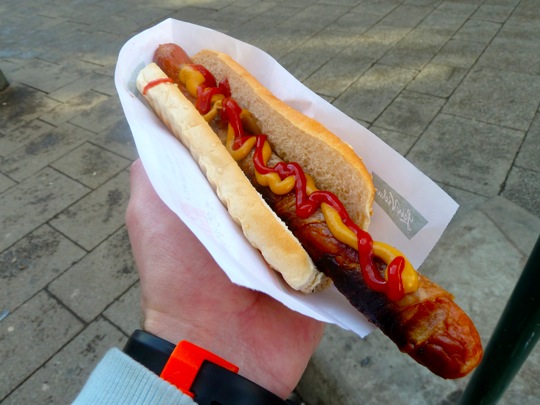
Lash it with mustard and tomato ketchup and you’ve got yourself a good, (albeit hugely fatty) tasty snack.
Boller
Available from every convenience store in town, these are like hot cross buns but without the decoration on the top. They’re bread like and made from a sultana filled dough. A very basic snack, but very cheap at only NOK 30 for 3.
Cafe Con Bar
Free wifi? Attraction point number one. After a solid day of traipsing across town, it’s good to sit down, enjoy a beer and check Facebook. It has a modern, chic kind of vibe with plenty of comfortable seating for taking a load off.
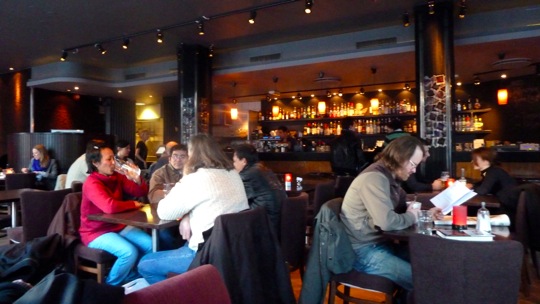
It’s located at the far end of Brugata in Grønland, and makes a good starting point for a bit of an Oslo pub crawl with the many bars in this area.
Dovrehallen
It doesn’t get more authentic and traditional than this joint on Storgata. This place serves up full on Scandinavian fare to locals that will put you solidly on your arse. This little piece here is called Eisbein, and it’s basically a steamed pork knuckle with potatoes and beans. I was dubious until I stuck my fork in and worked out what it was, but proceeded to give it a red-hot go. I didn’t manage to finish it. It destroyed me.
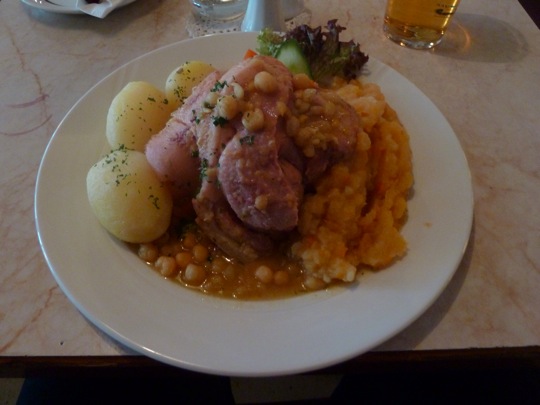
This place is filled with old-timers, all eating similar meals of epic protein, carb and fat content. You can tell they’ve been going there for years, and meet their mates there all the time. The meal and a beer was under NOK 200, so this place is one of the good budget places to check out for lunch/dinner that will leave you carrying a food baby afterwards.
Cafe Sara
Tucked away behind some scaffolding currently, Cafe Sara serves up quality Middle Eastern and Mexican food for reasonable prices in the vibrant Grønland area.
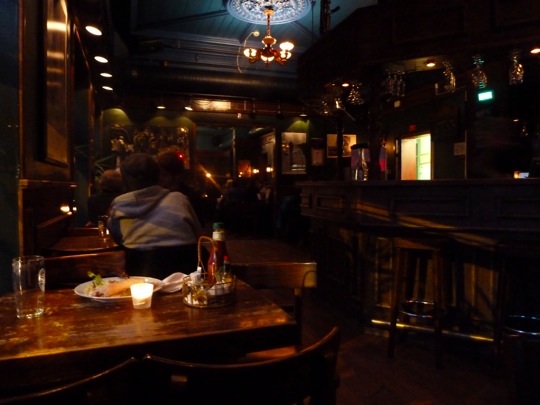
Both the beer and food is reasonably priced, with beers being about NOK 55 each and meals ranging around the NOK 140-200 price. No epic “let’s go swim across that fjord” inspiring Norwegian dishes here, but what they do serve is great for the price. The ambiance inside is friendly, with lots of locals coming in groups to have a hearty, cheap feed and enjoy a few beers in the darkly lit, but inviting setting.
How to get there
Flights to Oslo’s three airports – Gardermoen (OSL), Sandefjord (TRF), and Rygge (RYG) are provided by a number of carriers from a variety of UK airports. Which of these airports you fly into will depend on your budget and what’s available from your city, and will in turn impact how long it takes you to get into Oslo. I go into more detail in the next section on how far each airport is from the city. Flight time from the UK is about 2.5 hours.
London
British Airways and Scandinavian (SAS) operate flights to Oslo Gardermoen airport from London Heathrow. A return flight will set you back about £130 GBP with BA and about £110 GBP with SAS.
Ryanair fly from London Stansted and London Gatwick to Oslo Rygge. Fares with Ryanair will vary greatly, but return fares begin at £25 GBP. Ryanair also fly from London Stansted to Oslo Sandefjord, and these flights start at about £30 GBP.
Norwegian fly from London Gatwick to Oslo Gardermoen. Return flights start at approximately £135 GBP.
Manchester
SAS flies from Manchester to Oslo Gardermoen and a return flight will cost you about £150 GBP.
Edinburgh
Norwegian flies from Edinburgh to Oslo Gardermoen. Return flights begin at approximately £175 GBP.
Ryanair flies from Edinburgh to Oslo Sandefjord and a flight with these guys will start at £45 GBP.
From Airport to City
From Gardermoen (OSL)
Gardermoen is Oslo’s main airport, situated about 50 km north of the city, with all the full service carriers flying here. It’s a large, modern, clean and well connected airport with many options to get you into Oslo. The Flytoget Airport Express Train takes 19 minutes and leaves every 10 minutes. The privilege of the fastest way into Oslo costs NOK 170 one way to Oslo Sentral Station.
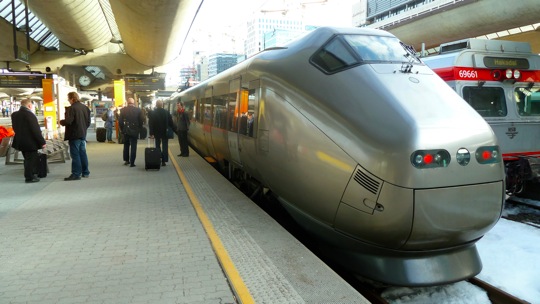
A cheaper options to get you into Oslo is the local NSB train, which goes to Oslo Sentral as well and takes about 40 minutes, costing NOK 110 one way.
From Sandefjord (TRF)
Sandefjord (Torp) is located about 110 km south-west of Oslo and is the furthest from the city. There are buses available to take you to Oslo, and are scheduled to coincide with arriving flights. The trip takes 1 hour and 45 minutes and costs NOK 190 for a single ticket or NOK 320 for a return.
From Rygge (RYG)
You’ll find Rygge Airport, Ryanair’s main hub for Norway about 60 km south-east of Oslo. Express buses shuttle between Rygge and Oslo, and cost NOK 130 for a single or NOK 320 for a return.
A bit of orientation
This map will give you a birds-eye view of everything I covered in the post, so you know where the key landmarks are to plan your trip better. Zoom out and pan around to get a feel for where everything is.
View 48 hours in Oslo in a larger map
Get around in Oslo
Purchase a 48 hour Oslo Pass from the tourist information office right out the front of Sentral Station for NOK 340. This includes free public transport city-wide, free entry to almost all the museums and attractions I mention in this post and more. It’s the cheapest and easiest way to see Oslo and get around.
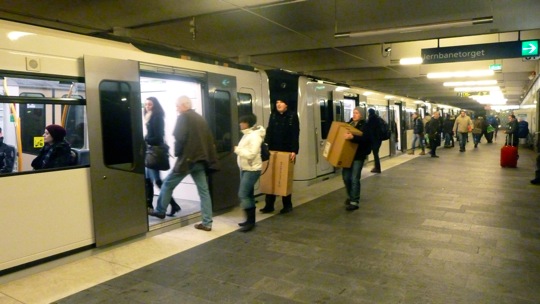
In terms of navigability, Oslo is easily traversed on foot around the central business district, however you will want to use the “T-Bane” (Metro), Trams and Buses to get to further out places like Holmenkollen and Bygdøy for the Fram and Viking Ship Museums. The main transport hubs of Jernbanetorget and Nationaltheatret provide all the bus, T-Bane and tram connections you need to get around Oslo.
Where to stay
I stayed in the Sentrum Pensjonat hostel during my time in Oslo. It’s very centrally located and the staff are friendly, with free wifi (although not throughout) and decent showers. The hygiene wasn’t good here however, and this was what I could deduce as the “most decent” hostel in Oslo. The two other hostels worth considering in Oslo are the Youth Hostel Haraldsheim (located about 4km out of town) and Ankers Hostel in the Grünerløkka district, but the reality is that Oslo isn’t a hostel friendly city. Consider a budget hotel instead for this trip, because you’re not missing out on a cracking social experience.
Budget
Ok, I’m not going to sugarcoat it. Oslo is expensive. Damn expensive. Don’t expect to get out of Oslo without parting with a good £300 in a weekend. Everything is pricey and it’s pretty difficult to avoid, but there are ways to be thrifty. Beer is unfortunately not one of these, so expect to pay NOK 55-75 per pint. Meals in the cafes/eateries I mentioned above will help you save some cash without skimping on culinary experience too much.
Oslo can be enjoyed in two ways. Accept that you’re going to be bent over backwards and enjoy your food and drink you normally would; or cut back hugely, don’t drink beer and only eat kebabs.
Conclusion
Oslo is like this interesting juxtaposition of traditional Norwegian culture, outlandishly expensive gastronomy and first world European efficiency, all wrapped up in an ice pack. On skis. And covered in snow.
In my opinion I would prioritise Scandinavian capitals in the following order from most to least recommended to visit: Copenhagen > Oslo > Stockholm. A final interesting mention, if you look like me, be prepared to be asked for directions LOTS. Apparently I look Norwegian, and had to turn away strangers 4-5 times asking for directions. So yeah, dye your hair brown and wear your biggest “I HEART LONDON” hoodie and carry a big DSLR. 😉